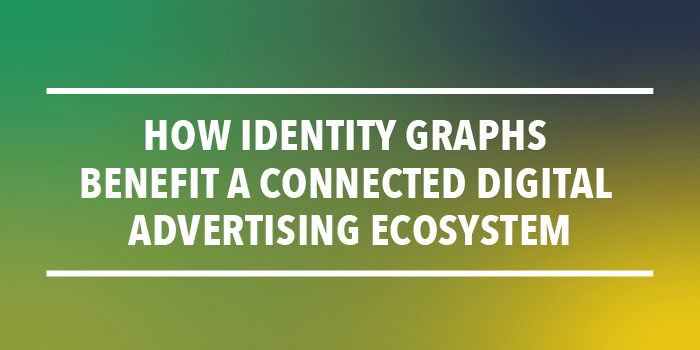
Consumers own more devices today than ever before and tend to switch between these along their journey to purchasing a product. Unfortunately, many marketers can’t connect customers to all their devices. For marketers, this represents a significant problem, as it can lead to an inconsistent experience with your brand and customer dissatisfaction.
As if this wasn’t challenging enough, recent privacy regulations and third-party tracking challenges have made understanding, finding and targeting customers even more difficult. The need to create comprehensive customer profiles and stitching data together has become table stakes for the digital advertising community. The secret to accomplishing this is using an identity graph. With identity graphs, you can target ads to your potential customers more effectively across channels, platforms and devices.
Understanding Identity Graphs
Many users access the internet from multiple devices, which offers marketers more paths to engage with customers, increased options for making purchases and no shortage of opportunities to gather data.
Of course, these circumstances often bring challenges, such as recognizing users across several touchpoints, devices and channels, then collecting this information in a single profile. If a marketing campaign doesn’t have a well-rounded view of a customer, they must start from ground zero each time someone accesses their content on a different device.
Understanding customer identity is a pivotal part of every marketing strategy, but how can marketers achieve this when their customers’ data exists across several devices? Here is where identity graphs come in.
What Are Identity Graphs?
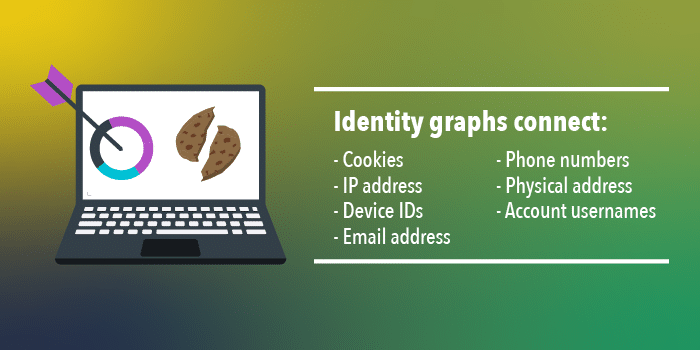
An identity graph is a tool used to obtain a unified customer view, connecting all the data on an individual user across devices and channels. Identity graphs get data from various sources, such as CRMs, e-commerce software and ad and marketing platforms. Essentially, identity graphs connect data across the online and offline landscapes.
An identity graph is a database, and it houses the identifiers associated with an individual visitor. Identity graphs collect personal identifiers, including:
- Cookies
- IP address
- Device IDs
- Email address
- Phone numbers
- Physical address
- Account usernames
These personal identifiers get collected and combined in one complete customer profile. The graph also includes behavioral data like past transactions and browsing history.
Through building an identity graph, you can establish a single customer view with these data points, and with this view, you can better target and understand customers. Rather than a device, the primary focus is on the individual customer. An identity graph helps marketers and publishers find similar customers via their behaviors, intent, or interests, and group them into audiences. These audiences are then used for targeting, personalization, upselling, and remarketing efforts. Since an identity graph provides a cross-device identity, this is a powerful tool for your marketing efforts.
Deterministic Matching & Machine Learning
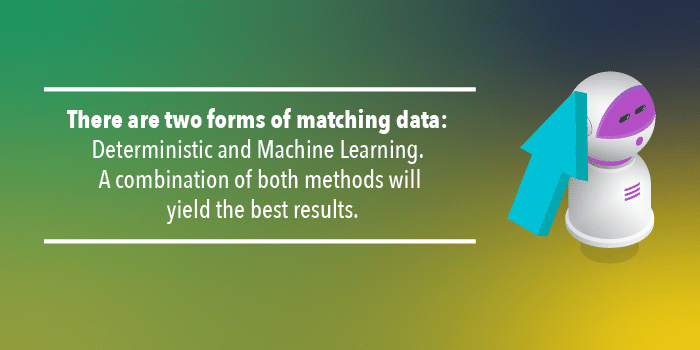
Deterministic matching and machine learning are two methods to group data and help build cross-device identities of customers. Deterministic matching tends to provide more accuracy, and machine learning tends to offer better scalability. Determining which is better for you comes down to the kinds of data you can access and what your business goals are. A combination of the two methods can complement each other and help you achieve both accuracy and scale.
- Deterministic matching: This type of matching allows you to recognize the same user across several devices by comparing their profiles. Deterministic matching can identify users across different screens by searching through data sets and tying together all profiles with a shared identifier. Login details i.e., emails, typically help achieve this matching. These recognized users can be referred to as “authenticated” users. While very accurate, authenticated users only equate to about 20% of the internet so don’t necessarily provide companies with the scale they need for campaigns.
- Machine learning: Use machine learning for better scalability. This type of matching uses distinct data sets with algorithms to identify a user across the multi-screen digital landscape. Included in machine learning are data like location, device type, IP address, Wi-Fi network, operating system and browser type. This type of matching can sometimes be referred to as “probabilistic.”
The benefits of a combination of Deterministic Matching & Machine Learning
While deterministic matching boasts more precision, machine learning offers scale that advertisers demand. Lotame’s powerful ID graph known as Cartographer maps several kinds of data in real-time through edge processing and big data analysis. Cartographer uses a combination of machine learning and deterministic matches to generate a people-based view of your data that spans:
- CRM
- Devices
- Purchases
- Cookie data
- Customer IDs
How to Use Identity Graphs to Connect Data
You can use identity graphs to make better digital connections. When identity graphs are not already in place, a customer may see an ad for a product they already own. For example, someone may have searched for this product from their phone and then bought it on their laptop.
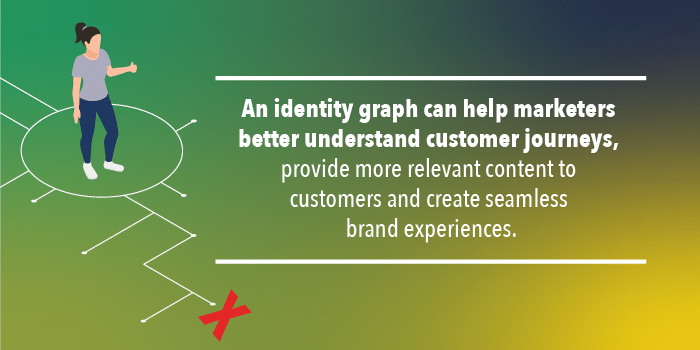
The marketing behind this product was not sophisticated enough to determine this user has already converted. People-based marketing, however, is different, as it uses marketer-collected data to identify customers and their behaviors. Many marketers use tracking pixels and cookies to see when a user accesses a website or ad from a device. People-based identity graphs can inform you when a user accesses this information across various platforms. The following are four steps to identify and connect your users.
- Collect and organize your first-party data. In your CRM, you probably capture customer phone numbers, emails, purchase histories and occupations. You may also have information if your customers have interacted on your channels, such as downloaded gated content or newsletter subscriptions.
- Enrich that data with third-party data for a more holistic view. Seek high-quality data partners to add dimension and depth to your first-party data. You can add demographic, behavioral, geographic, and other types of data to learn more about your customers and find new ways to monetize those audiences.
- Use an ID graph to make connections down to the individual level. The data solution you choose will connect and cluster your customers across browsers, domains, devices and IDs. Your database will link your first-party data to all instances of their identity, including their visit to other websites.
- Form audiences for personalized advertising. The solution you choose will package customer data to help you make sense of it. You will be able to identify, reach and segment every individual you wish to target. You can map customer journeys and learn more about how effective your strategies are with different users and across platforms. Publishers will be able to segment readers and position themselves with superior targeting to advertisers.
An identity graph can help marketers better understand customer journeys, provide more relevant content to customers and create seamless brand experiences.
- Better understand customer journeys: Consumers in the U.S. use mobile devices for much of their online time. If marketers are relying on outdated cookie-based technologies, they are missing a significant piece of the puzzle as mobile does not use cookies. When a marketer can view a customer’s behaviors across devices, they can discover and react appropriately to needs, wants and actions across devices at every stage of the journey.
- Create seamless brand experiences: Customers want a consistent experience with a brand. When their experience is inconsistent from device to device, consumers may form a negative impression of the brand. When you can recognize a customer as they switch between devices, your brand will be able to continue the same conversation with the person throughout their path to purchase.
- Provide more relevant content to customers: If you can’t recognize the same user across multiple devices, you may not be able to successfully implement your advertising campaign or move that consumer closer to purchase. For example, if you only want your ad to display to the same person five times, but you can’t track them across multiple devices, you may serve this ad to the same individual more than five times. Through a people-based approach, you can reach customers with more relevance and precision, reducing oversaturation and wasted ad spend.
Identity Graphs for a New Technological Future
Mounting privacy regulations and third-party tracking challenges have created an identity crisis in digital advertising. Without third-party tracking, marketers stand to lose many tools that enable them to buy digital advertising effectively and efficiently. Similarly, If publishers cannot satisfy these marketer needs in the absence of third-party tracking, they may face ad revenue declines and further degrade their ability to monetize their audiences. The loss of third-party cookies is less about the cookies and more about the loss of third-party tracking and the pressures of privacy compliance.
Third-party tracking facilitates the following:
- Optimization
- Measurement
- Personalization
- Frequency management
- Ability to find and engage consumers across the web
Connections have never been more crucial, and during this phase of great change, marketers, publishers, agencies and media companies will need to discover new ways to find the right data about their customers, to connect and have the necessary tools to strengthen relationships and grow their business.
Identity graphing can stitch together disparate sources of data across devices, platforms, contexts and time. Identity graphing supports data collection, activation and organization across channels and platforms. This solution has evolved as a result of a switch from third-party cookies to first-party, domain-specific ones.
Identity graphs are one way to prepare for this phaseout, and they can provide marketers with various benefits.
- Address real-time customer needs: The digital world fast-tracks user interactions, which forces marketers to identify and meet a customer’s requirements without delay. As such, an organization needs technology that can collect, match and activate data in real time.
- Optimize personalization: With an identity graph, you can optimize personalization by identifying and understanding an audience’s preferences, wishes and desires to provide them with relevant content. Identity graphs will help you obtain a full customer profile that blends their offline and online interactions with your brand. You can update and enrich customer data to optimize your marketing campaign’s results.
- Improve cross-device attribution: When you take advantage of an identity graph, you can identify the roles each of the channels perform in user conversion. You will be able to more accurately attribute conversions when you have a more comprehensive picture of the customer journey. Further, you can customize messages to customers and reduce budget waste. No matter how often your customers switch between devices, they will be able to engage optimally with your content.
- Enhance customer engagement: Identity graphs allow you to match digital identifiers and behavioral data with offline data, and as such, marketers can better engage with their customers. With a well-rounded customer profile, you can predict a customer’s future needs, improve your marketing campaigns and find better opportunities to get lost customers engaged again.
Lotame Panorama ID for the Digital Advertising Ecosystem
Powered by our Cartographer identity graph, we have created Lotame Panorama ID, which offers a common language for sellers and buyers to transact on cross-channel advertising. Whereas Cartographer is our identity graph, this solution is the output: a digital identifier that is shareable, privacy-compliant and interoperable across any platform, device, browser, or ID. Lotame Panorama ID is the only global ID that can:
- Provide relevant omnichannel digital advertising.
- Protect a consumer’s privacy via universal opt-out.
- Interoperate across digital advertising.
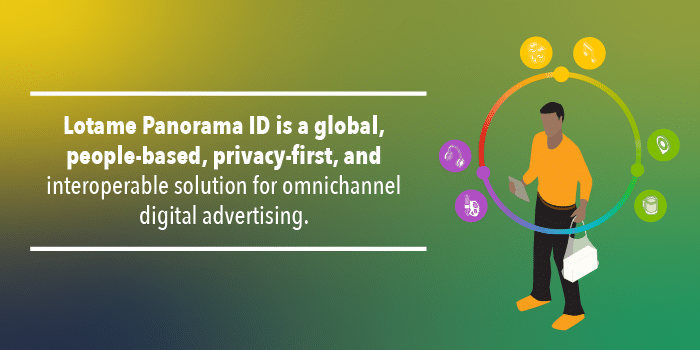
Through Lotame Panorama ID, consumers will have control to view and own their privacy choices, regardless of the device, and the marketplace will have access to a solution that connects privacy choices everywhere. Using a multitude of identifiers — web data, customer IDs, and hashed email — and both deterministic and machine learning approaches, our enriched identity solution makes it possible to reach and message the vast majority of consumers on connected devices. Additionally, Lotame Panorama ID supports and improves third-party tracking and eliminates dependence on the third-party cookie.
Our privacy-first, open-to-all, people-based approach delivers the most robust ID for optimal consumer experiences and cross-channel targeting globally. Fill out the form below to learn more.